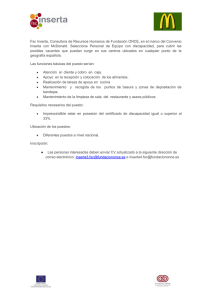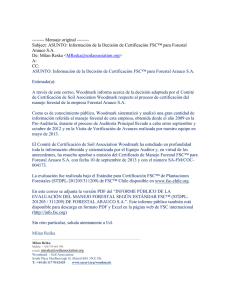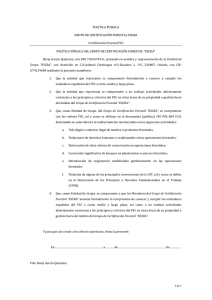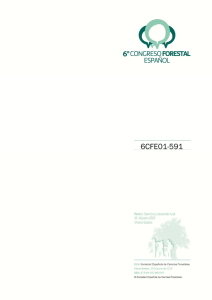factibilidad del cumplimiento de certificación grupal por fsc en una
Anuncio
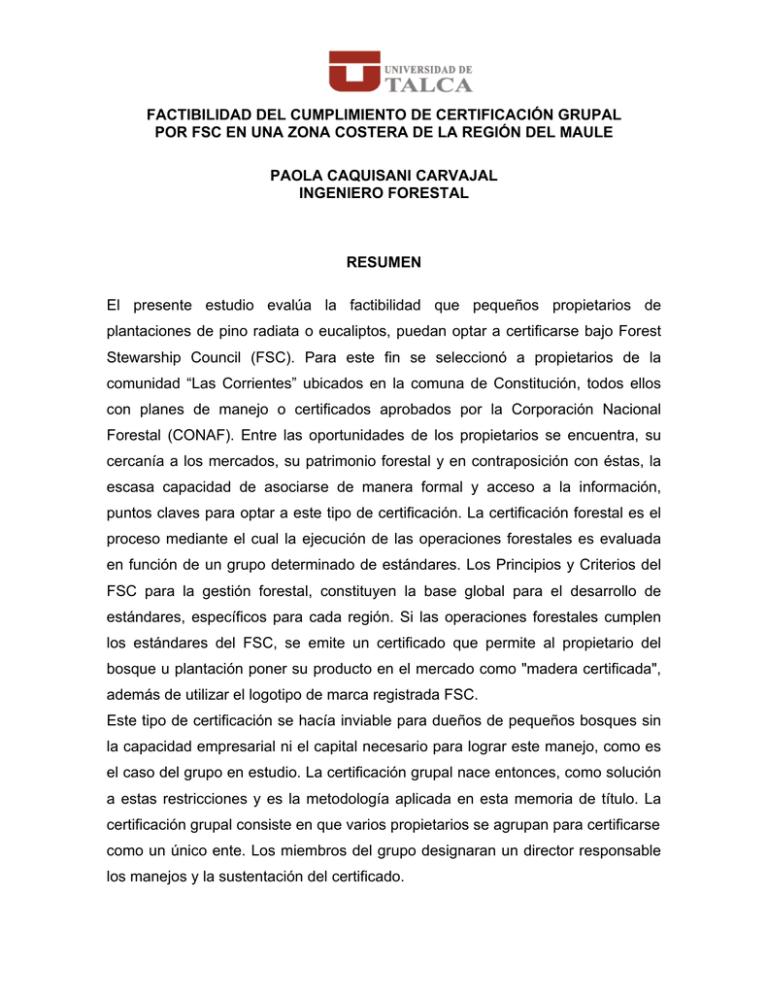
FACTIBILIDAD DEL CUMPLIMIENTO DE CERTIFICACIÓN GRUPAL POR FSC EN UNA ZONA COSTERA DE LA REGIÓN DEL MAULE PAOLA CAQUISANI CARVAJAL INGENIERO FORESTAL RESUMEN El presente estudio evalúa la factibilidad que pequeños propietarios de plantaciones de pino radiata o eucaliptos, puedan optar a certificarse bajo Forest Stewarship Council (FSC). Para este fin se seleccionó a propietarios de la comunidad “Las Corrientes” ubicados en la comuna de Constitución, todos ellos con planes de manejo o certificados aprobados por la Corporación Nacional Forestal (CONAF). Entre las oportunidades de los propietarios se encuentra, su cercanía a los mercados, su patrimonio forestal y en contraposición con éstas, la escasa capacidad de asociarse de manera formal y acceso a la información, puntos claves para optar a este tipo de certificación. La certificación forestal es el proceso mediante el cual la ejecución de las operaciones forestales es evaluada en función de un grupo determinado de estándares. Los Principios y Criterios del FSC para la gestión forestal, constituyen la base global para el desarrollo de estándares, específicos para cada región. Si las operaciones forestales cumplen los estándares del FSC, se emite un certificado que permite al propietario del bosque u plantación poner su producto en el mercado como "madera certificada", además de utilizar el logotipo de marca registrada FSC. Este tipo de certificación se hacía inviable para dueños de pequeños bosques sin la capacidad empresarial ni el capital necesario para lograr este manejo, como es el caso del grupo en estudio. La certificación grupal nace entonces, como solución a estas restricciones y es la metodología aplicada en esta memoria de título. La certificación grupal consiste en que varios propietarios se agrupan para certificarse como un único ente. Los miembros del grupo designaran un director responsable los manejos y la sustentación del certificado. Los resultados de este estudio, para el caso de estos propietarios señala que, antes de iniciar un proceso de certificación es necesario sensibilizar a los pequeños productores, apoyándolos a implementar los estándares viables de aplicar en las plantaciones en el corto plazo, trabajando en forma individual la producción y grupal la comercialización, dejando para plazos posteriores el cumplimientos del resto de los indicadores, tal como se sugiere en el desarrollo de la memoria. Por otro lado, se proponen mecanismos de certificación vinculados a procesos, parecido a las normas de la Organización Internacional de Normalización (ISO), y no a mínimos absolutos, como es el caso en el sistema FSC, permitiendo que el punto de partida sea más flexible, de tal manera que el pequeño propietario progresivamente vaya acercándose al estándar ideal. SUMMARY This study evaluates the feasibility that small landowners of radiata pine or Eucalyptus plantations, can opt to certificate under Stewarship Council (FSC). It has been selected for this purpose landowners of the “Las Corrientes “ community,located in Constitución, all of them with management plans or approved certificates by the Corporación Nacional Forestal (CONAF). Among the opportunities of the landowners we can find their nearness to the markets, their forest inheritance and, opposite to these, the scarce capacity either associating in a formal way or accessing to the information; these are important points to opt and obtain this kind of certification. The forest certification is the process through which the execution of the forest operations is evaluated in function of a specific group of standards. The FSCprinciples and guidelines for the forest management constitute the global basis for standard development, specific for each region. If the forest operations carry out the FSC standards, it is emitted a certificate that allows the forest or plantation’s owner to put his / her products in the market as a “certificated wood “and he/she will also be able to use the FSC trademark logo. This type of certification used to be non-viable for the owners of small forests with no managing capacity or the necessary capital to achieve this management as in the case we are studying. The collective certification comes up as the solution to this restrictions and it has been the applied methodology in this academic memory. The collective certification is composed by many owners who are grouped to certificate as one entity. The group members designate a director responsible for the certification management and support. The results of this study according to the owners indicate that, before starting a certification process it is necessary to sensitize the landowners, supporting them in the short term viable standard implementation, working the production individually and the commercialization in a collective way, leaving the accomplishment of the rest of the indexes for another time, such as it is suggested in the development of this memory. On the other hand, certification mechanisms connected to processes are proposed. These mechanisms are very similar to those of the International Standardization Organization (ISO) and not to an absolute minimum, just as in the FSC, allowing the flexibility to the starting point, thus the small landowner progressively goes getting closer to the ideal standard.


